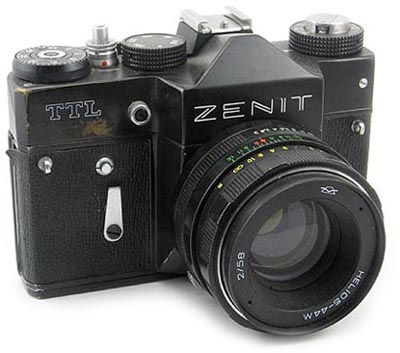
Zenit 35mm SLR
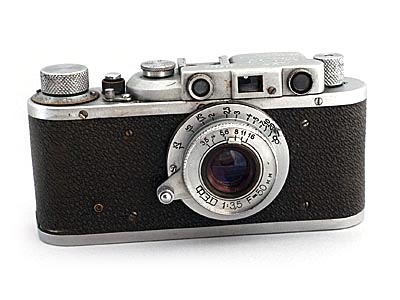
First produced in 1934, the FED 1 is a copy of the Leica II camera. The serial number of this camera, one of the NKVD types, dates it to 1937. Although copies, the FED copies were quite well built. The camera has a heavy, solid feel. I found this camera in a thrift shop in Green Valley, AZ. The rangefinder works, but the shutter does not appear to work on this example, probably because someone unknowingly set the shutter speed before cocking the shutter. The lens is a FED f/3.5 50mm collapsible lens, also a copy of the Leitz Elmar
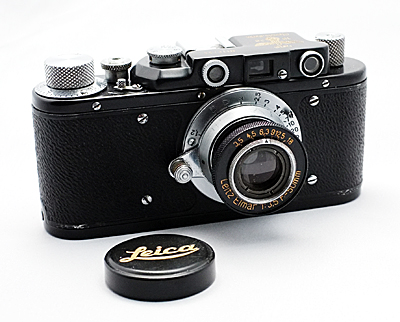
Produced from 1948 to 1956, the Zorki 1 is a copy of the Leica II camera. The Zorki 1D was introduced in 1953. Zorki 1D and 1E cameras usually had stamped, rather than engraved lettering. This made it easy to create fake Leica IIs. In the mid-1990's, hundreds of 1953 Zorki 1D's and 1E's (1954-1956) were made into fake Leica cameras, complete with Leica and Leitz lettering on the top plate. Some, like this example, were engraved with fake German or Nazi "commerative" logos. This one is supposed to be a 1936 Berlin Olympics "commemorative" camera. I've never seen any evidence that Leica issued any commemorative Leica II's, but after the collapse of the Soviet Union, unsuspecting tourists to Russia bought these fake Leicas that were sold as supposed captured WWII war booty. I removed the fake Nazi top plate and replaced it with an original Zorki top plate I bought online, and painted it to match the rest of the camera.
This one is complete with an Industar-22 50/3.5 lens rebranded as a Leitz Elmar. The Zorki 1, like the FED above, is actually a pretty well built camera. This one is functional, although desperately in need of a CLA.
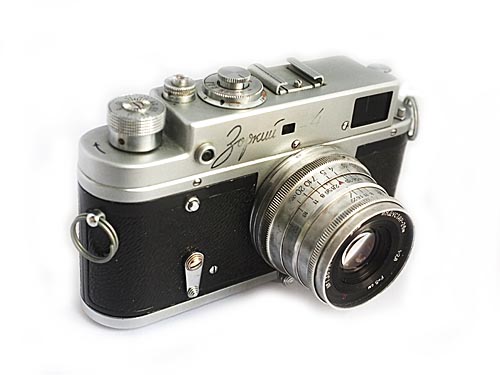
Another Russian camera that actually takes pretty decent photographs, the Zorki 4 is essentially a copy of the Leica II, although it looks a bit more modern, in my opinion. The Zorki 4 was produced from 1956 to 1973, and many were exported to western countries. The Zorki 4 is large and heavy compared to some of the contemporaneous rangefinder cameras. There are quite a few variations of the Zorki 4, and those built up through the end of the 1960's demonstrate better craftmanship and quality that later models. Even by 1963, cost cutting was apparent. The lettering was silk-screened rather than engraved. You can see that the lettering on the front is wearing off, as is some of the lettering on the controls.
Taking photographs with the Zorki is very old school, although one nice touch is the combined viewfinder and rangefinder, with diopter adjustment. It is by far the easiest rangefinder in my collection to focus and compose. I had fun using it. The shutter must be cocked before adjusting the shutter speed to avoid damaging the shutter mechanism. This one is equipped with the Industar-26M 50/2.8 lens in M39 mount.
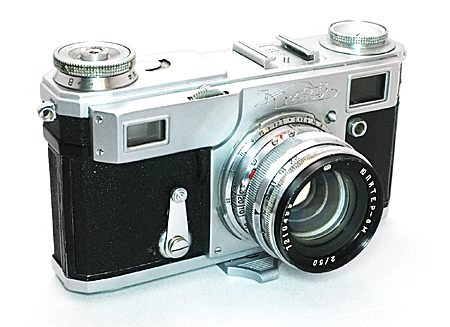
The Kiev 2 is a Russian clone of the pre-WWII Contax II. I found this copy, fitted with a nice Jupiter-8M lens, on EBay. This camera has had a recent CLA, according to the seller, and I have used it with good results.

Zenit 35mm SLR
The Zenit TTL was a Russian made camera produced from 1977 to 1985. The build quality is impressive. It features TTL metering. The camera itself is big, built like a tank, and weighs a ton. I found this one at a flea market for $7.00. Although I've never used the body, I have mounted and used the well regarded Helios 44M via an adapter on my Fuji X-Pro1 and X-E2 with very nice results.
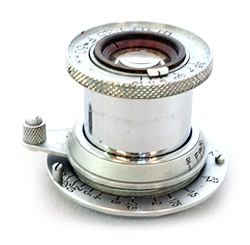
FED 50mm f/3.5 Elmar copy
FSU lenses are mostly copies of pre-WWII Leica and Zeiss lenses. These lenses were often produced in the millions from the 1930s up to contemporary times, which makes them very affordable and easy to find, especially on EBay. Most were produced in Leica Thread Mount (LTM, L39 or M39) for the many FSU copies of Leica cameras. Some were produced in Contax Rangefinder mount (CRF) for the Kiev copies of the Contax II and III cameras.
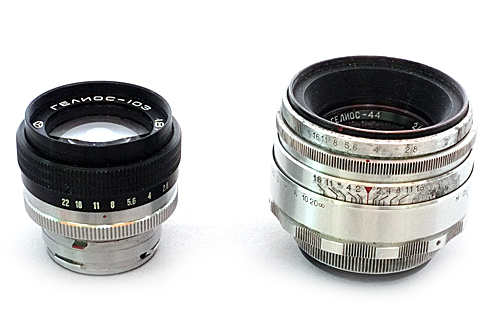
Although the lens designs were copies of the Leitz Elmars and such Zeiss lenses as the Tessar, Sonnar, and Biotar, the workmanship is not up to the German standards. Finding a good example of an FSU lens can be a challenge. Many of the earlier lenses were made of light aluminum, which makes them easily damaged if dropped, and it's not unusual to find that they have damaged filter threads. Many of the FSU lenses do not have click stops for the f/stop settings. One problem with adapting these lenses for use on mirrorless cameras is that some may not focus to infinity unless modified.
In the 1950's, Helios produced lenses in M42 mount for Zenit SLR cameras. A Helios 44M is shown mounted on the Zenit SLR pictured above. Manufactured from the 1950's up to the present, the Helios 44 and its variants are thought to be the most produced lens in the world. At far right is an early Helios 44 58mm f/2 in Leica thread mount, and a fast Helios 103 53mm f/1.8 in Contax Rangefinder mount.
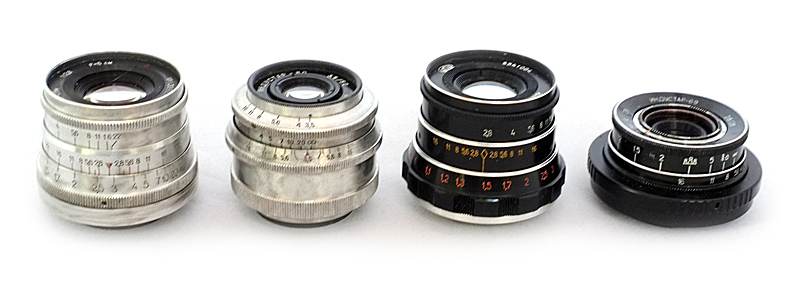
Industar lenses were produced in many variations for FED and Zorki copies of Leica cameras. From left to right, are an Industar 26M 5cm f/2.8, an Industar 50 f/3.5 rigid Elmar copy, an Industar 61L/D 55mm f/2.8 lens, considered by some to be the best FSU lens made, with Lanthanum glass and click stops for the f/stops. Last is an Industar 69 28mm f/2.8 wide angle lens, one of those
lenses that won't focus to infinity. I had a machine shop deepen the optical block mounting threads an additional 1.5mm so that the lens will focus to infinity on my Fuji X-E2. The Industar 69 is actually a very small pancake lens, shown here mounted on a LTM-FX adapter for Fuji X cameras.
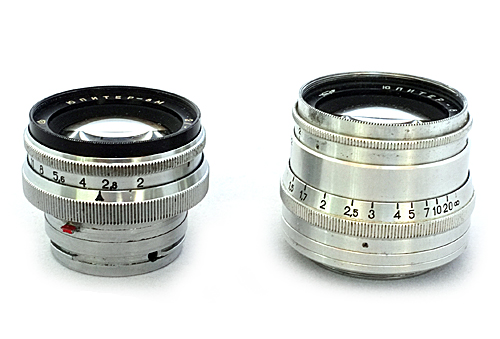
A favorite lens of adapted lens users is the Jupiter 8, a 50mm f/2 copy of the Zeiss Sonnar 50mm f/2 lens. The Jupiter 8 is sharp in the center, getting softer toward the edges, with low contrast and often flare, to create a dreamy look to images taken with it. The Jupiter 8 can be found in both LTM and CRF mounts.
Optically, the FSU lenses are typically sharp in the center and soft in the corners and edges. Some are desired because of their swirley bokeh. Early lenses generally lack coatings, so flare is not unusual and may impart a dreamy quality to the lens. All these optical flaws are actually desired by many usuers for the unique rendition of the images taken, proividing an opportunity for creative imagery unobtainable with today's supersharp, corrected lenses.
In spite of their shortcomings, these lenses are avidly collected and today are often used on interchangeable lens mirrorless cameras from Fuji, Sony, and others. Adapters are available for most mounts. I've used all the lenses shown above on a Fuji X-E2 or X-Pro1 with an appropriate adapter. There is much more information on the internet about adapting these lenses and their qualities.